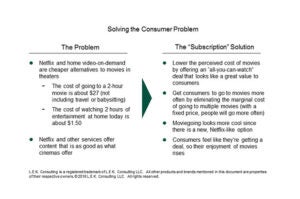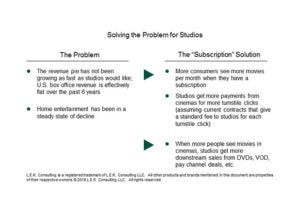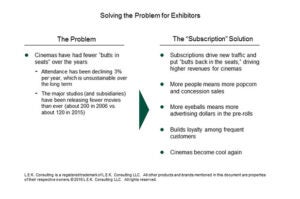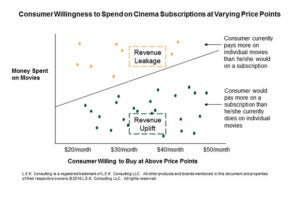A subscription-based structure can make going to the cinema cool and cost-competitive again
Our box office trends series[1] has taken us through the highlights of the theatrical business today and some of what the future has in store. In our last two posts, we discussed some potential ideas that could help curb the problems faced by exhibitors, but neither flexible ticket pricing[2] nor the Screening Room in-home viewing proposal[3] is likely to be the savior. This post focuses on what we believe is the most promising idea for the movie industry: subscriptions.
Many of us already subscribe to entertainment services, such as cable TV, broadband, Netflix/Hulu/Amazon Prime Video and Spotify/Pandora/Apple Music/SiriusXM. We also subscribe to wireless carriers for our mobile phones, newspapers, magazines, gyms, wine clubs and amenity services like Dollar Shave Club and meal services like Blue Apron. The list goes on and on.
Also Read: Should Movie Theaters Use Flexible Ticket Prices Like Airlines Do? (Guest Blog)[4]
But why, exactly, are subscriptions so popular? Consider the following:
- Subscriptions look like a tremendous value. All-you-can-eat buffets are a customer favorite because of their perceived value. In the same vein, an all-you-can-watch subscription to cable TV seems like a bargain because it offers more entertainment than you could ever watch.
- Subscriptions put you in control. With monthly fixed-price subscriptions, you always know how much you pay. It is much safer for you to give kids access to Netflix than it is to let them rack up bills with cable TV pay-per-view ordering.
- Subscriptions are convenient. Your subscription services are always available. You don't have to order them every time you want to use them. After all, who wants to enter a credit card number to make every single purchase?
- Subscriptions provide variety. Because you do not pay extra to browse Netflix, your perusing leads you to watch a bunch of cool stuff you did not even know was available. In addition, such services' recommendation engines help you discover new and intriguing options. Similarly, meal services like Blue Apron introduce subscribers to tasty ingredients and dishes.
Many subscriptions are content-based, and movie theaters offer some of the best content on the planet. But could a monthly subscription for all-you-can-watch movies in the cinema work in the U.S.?
Also Read: Where Movie Studios Must Turn to Fix Their Failing Theatrical Fortunes (Guest Blog)[5]
Actually, "Netflix-for-cinemas" is not a new idea. It is already a proven model in the U.K., where the theater chains Cineworld and Odeon offer monthly subscriptions for $20-30 (about £16-20), depending on whether you are in central London or not.
Here is the ad for Odeon's product, Limitless:

- The right to view an unlimited number of films, but no more than one per day, at the cinema chain
- A discount of 10 percent to 25 percent off all in-cinema food and drink purchases at all times
- Invitations to advance screenings for members
- Access to premium seating in selected theaters
- Entry to high-demand screenings
If cinema subscriptions work in the U.K., why not try them here in the U.S.?
Also Read: Why Movie Studios Need China to Build More Theaters (Guest Blog)[6]
We know consumers would sign up. Not only has proprietary L.E.K. consumer research found support for the idea in the U.S. but a movie subscription would address problems that consumers have:



Perhaps the most important factor in subscription services' success is pricing. If theaters' monthly fees are too high, consumers will not buy in; if they're too low, cinemas get hurt because lots of consumers show up and they pay much less than they did before.
Also Read: Why 3D Is No Longer Hollywood Studios' Savior (Guest Blog)[7]
Studios and exhibitors are especially concerned about under-priced subscriptions, which expose them to revenue cannibalization. In other words, studios and theaters would lose revenue by offering a flat-fee subscription service to frequent moviegoers who otherwise would pay full price for tickets.
The same issue is at play with gym memberships, which are profitable because some members go often (the gym rats who work out a lot, resulting in a low cost per visit) and others don't (the rest of us, who consequently pay a lot per visit). Gyms profit from this phenomenon, which is called "breakage." Similarly, many cinemas that sell subscriptions often find that members don't take advantage of their privileges nearly as often as they could, so cinemas also profit from breakage. With proper pricing, CrossFit and others like them have set a good balance that generates great growth with good economics.
Through our research on subscription participation and pricing, L.E.K. Consulting has determined that members who use their subscriptions very frequently get a better deal than they would have by purchasing individual products or services, though other stakeholders experience some revenue leakage.
Also Read: How Studios Use Blockbuster Budgets to Boost Moviegoing Attendance (Guest Blog)[8]
However, there are many more consumers who purchase subscriptions and pay more than they would have if they had bought individual products or services. As a result, under a cinema-subscription model, there a lot of people who will spend more on movies than they spend today. To be specific, a person who goes to the movies once a month pays just $10 for one ticket. If that person were to buy a cinema subscription for $25 per month, studios and theaters would experience a strong revenue uplift — they would more than double the revenue they get from that consumer.
L.E.K.'s proprietary research, as illustrated in the figure below, shows that there is more leakage with lower price points and there is more revenue uplift with higher prices.

The U.S. movie industry needs only look to at similar operations in the UK for guidance on the following topics, among others:
- Tiers of subscription packages
- Optimal pricing structure
- How revenues are shared between studios and revenue share vs. per capita price)
- Program rules (e.g., exceptions)
- Tech support structure
Also Read: Why Theaters and the Moviegoing Experience Need an Overhaul (Guest Blog)[9]
Perhaps the greatest obstacle to bringing cinema subscription services to the U.S. will be convincing studio and exhibitor executives to cooperate in the rollout of a new initiative, given their general distrust of each other in the past. The industry needs sophisticated market research to model how subscription services will benefit the various stakeholders, as well as a beta test or pilot in a few cities to prove the economic feasibility and get the relevant parties to buy in. And, of course, planning for the logistics of membership.
Without question, this is hard to do. But in the current environment of declining admissions and strong competition, the risk of doing nothing will be the harder and more dangerous choice.
This concludes our box office trends series. Next week, we will begin examining the TV landscape.
This is the final part in a series by Dan Schechter, Gil Moran, and Michael Kaufman from L.E.K. Consulting's Media, Entertainment & Technology consulting practice.[10] [11][12][13]
References
- ^ box office trends series (www.thewrap.com)
- ^ flexible ticket pricing (www.thewrap.com)
- ^ the Screening Room in-home viewing proposal (www.thewrap.com)
- ^ Should Movie Theaters Use Flexible Ticket Prices Like Airlines Do? (Guest Blog) (www.thewrap.com)
- ^ Where Movie Studios Must Turn to Fix Their Failing Theatrical Fortunes (Guest Blog) (www.thewrap.com)
- ^ Why Movie Studios Need China to Build More Theaters (Guest Blog) (www.thewrap.com)
- ^ Why 3D Is No Longer Hollywood Studios' Savior (Guest Blog) (www.thewrap.com)
- ^ How Studios Use Blockbuster Budgets to Boost Moviegoing Attendance (Guest Blog) (www.thewrap.com)
- ^ Why Theaters and the Moviegoing Experience Need an Overhaul (Guest Blog) (www.thewrap.com)
- ^ Dan Schechter (www.lek.com)
- ^ Gil Moran (www.lek.com)
- ^ Michael Kaufman (www.linkedin.com)
- < small>^ L.E.K. Consulting's Media, Entertainment & Technology consulting practice (www.lek.com)
Source → Why Netflix�s Model May Offer the Salvation That Movie Theaters Need (Guest Blog)




